Main Control Factors and Hydrocarbon Accumulation Model of Volcanic Oil Reservoirs with Complex Oil–Water Relationships: A Case Study of the Carboniferous in the Chepaizi Uplift, the Junggar Basin, China
Abstract
1. Introduction
2. Geological Settings
3. Materials and Methods
4. Results
4.1. Source Rock
4.2. Fault Characteristics
4.3. Reservoir Characteristics
4.4. Fine Depiction of Volcanic Rocks
4.5. Oil–Water Distribution Characteristics
5. Discussion
5.1. Matching between Faults and Source Rocks Controls the Macro-Scale Distribution of Oil Reservoirs
5.2. Volcanic Rock Bodies Constrain Reservoir Distribution
5.3. Structural Evolution Adjusts the Reservoir Distribution Pattern
5.4. Reservoir Physical Properties Control the Differentiation of Oil, Gas, and Water
5.5. Hydrocarbon Accumulation Model
6. Conclusions
- (1)
- The Carboniferous volcanic rock reservoir in the Chepaizi Uplift is composed of seven volcanic rock bodies developed under the fault block setting. The volcanic rock bodies vertically stack over each other and present a bead-string connected planar distribution along the Hongcheguai fault, with a volcanic rock distribution area of nearly 50 km2, which features the concentration of Carboniferous volcanic rock reservoirs in the study area.
- (2)
- The oil–water relationship of the Carboniferous volcanic rocks is complex. The oil–water distribution is usually based on units of volcanic rocks. The oil–water distributions in adjacent volcanic rock bodies are independent of each other and there may be multiple oil–water interfaces within one volcanic rock body.
- (3)
- The Carboniferous volcanic reservoir experienced two stages of hydrocarbon accumulation from different source rocks. The distributions of faults penetrating hydrocarbon kitchens and source rocks control the macro-scale distribution of reservoirs, while the physical properties of reservoirs determine the oil–water differentiation in volcanic rock bodies. The lithofacies-controlled model highlighting “one rock body for one reservoir” decides the distribution of reservoirs and the matching between the paleo-structure and hydrocarbon accumulation stages controls the accumulation and adjustment of hydrocarbons. The hydrocarbon accumulation model of the Carboniferous volcanic reservoirs in the Chepaizi Uplift is summarized as two stages of hydrocarbon accumulation of newly generated oil and gas into older reservoir rocks with different source rocks. Specifically, the Permian source rocks in the Shawan Sag offer lateral hydrocarbon supply and hydrocarbons accumulate in the Carboniferous structural-lithologic traps. The findings of this research provide guidance on the efficient development of the volcanic reservoirs with complex oil–water relationships in the study area.
Author Contributions
Funding
Data Availability Statement
Acknowledgments
Conflicts of Interest
References
- Jin, J.; Wang, J.; Yang, Z.; Liu, J.; Ji, H.C.; Jia, H.B.; Zhang, X.G. Well logging identification of Carboniferous volcanic inner buried-hill reservoirs in Ke-Bai Fault Zone in Junggar Basin. Lithol. Reserv. 2018, 30, 85–92. [Google Scholar]
- Wang, L.; Li, J.H.; Shi, Y.M.; Zhang, L.W. The identification and prediction of Carboniferous volcanic rocks in Dixi area, Junggar Basin. Acta Petrol. Sin. 2010, 26, 242–254. [Google Scholar]
- Pan, H.; Li, X.; Qian, C.C.; Song, J.Q.; Luo, G.X. Characteristic and accumulation Patterns of Carboniferous Inside-Type volcanic Reservoir in Kebai Fault Zone of Junggar Basin. J. Northeast. Pet. Univ. 2022, 46, 62–75. [Google Scholar]
- Huang, Y.; Liang, S.Y.; Yang, D.S.; Ji, D.S.; Fu, X.P. Characteristics and Main Controlling Factors of Primary Rhyolite Volcanic Reservoir. Spec. Oil Gas Reserv. 2021, 28, 54–61. [Google Scholar]
- Masab, A. Pore Structures and Reservoir Characteristics of Volcanic Rocks. In The Carboniferous Batamayineishan Formation in Shuangjingzi Area, Eastern Junggar Basin; Jilin University: Jilin, China, 2021; pp. 16–23. [Google Scholar]
- Wang, K.; Feng, Z.; Zhang, Y.; Wang, D.K. Identification of the lithology of Carboniferous and its reservoir characteristics in Chepaizi uplift, Junggae basin. J. Southwest Pet. Univ. Sci. Technol. Ed. 2014, 36, 21–28. [Google Scholar]
- Cheng, C.L.; Sun, Y.; Zhang, F.; Shang, F.K.; Yuan, L.; Ren, X.C. The control factors and distribution of favorable gneous reservoirs in Chunfeng oilfield. J. Oil Techenol. 2014, 36, 54–59. [Google Scholar]
- Liu, H.J. Study on Hydrocarbon Accumulation Law for Volcanic Rockreservoirs in Hongche Fault Belt, Junggar Basin; China University of Petroleum (EastChina): Qingdao, China, 2013; pp. 52–55. [Google Scholar]
- Wang, X.J.; Qi, H.Y.; Wu, B.C.; Zhou, L.J. A New Understanding of the Carboniferous Oil Reservoir and Its Rolling Evaluation Practice in the Chepaizi Area; Shanxi Petroleum Society: Xi’an, China, 2018; pp. 1–6. [Google Scholar]
- Xing, F.C.; Lu, Y.C.; Liu, C.H.; Xiang, K. Structural-paleogeomorphologic features of Chepaizi area and mechanism of their control on sandbodies. Oil Gas Geol. 2008, 29, 79–83. [Google Scholar]
- Shang, F.K.; Chen, L.; Wang, L.; Han, Z.H.; Liu, Z.C. Main controlling factor and hydrocarbon accumulation modes of volcanic rock oil reservoirs in Chepaizi Uplift. J. Northeast. Pet. Univ. 2015, 39, 13–22. [Google Scholar]
- Liu, W.F.; Liu, S.L.; Sun, L.X. Type and Characteristics of Permian Andesite Reservoir in Tiaohu Sag, Santanghu Bain. XJPG 2000, 21, 483–486. [Google Scholar]
- Yu, B.L.; Liu, X.L.; Fan, S.F.; Liu, H.; Wang, K.M. Seismic Technique and Application of Volcanic Rock Facies. Xinjiang Pet. Geol. 2009, 30, 264–266. [Google Scholar]
- Qiu, J.; Zeng, G. Early Paleozoic Marine Volcanic Rocks and Mineralization in Lajishan; China University of Geosciences Press: Wuhan, China, 1997; pp. 54–61. [Google Scholar]
- Li, J. The Study on Distribution Characteristies and Controlling Factors of Carboniferous Volcanic Reservoir of the Northwestern Margin, Junggar Basin; China University of Geosciences: Beijing, China, 2008; pp. 55–58. [Google Scholar]
- McMasters, G.E. Deep Reservoirs basin gas trap, western Canada. AAPG Bull. 1979, 63, 152–181. [Google Scholar]
- Wang, X.L.; Zha, M.; Xia, H.P.; Chen, Z.H.; Kong, Y.H.; Jiang, R.F. Forecast and Assessment of Oil and Gas Resources in Carboniferous, Northern Xinjiang. Adv. Earth Sci. 2012, 27, 80–85. [Google Scholar]
- Gao, G.; Wang, X.L.; Liu, G.D.; Zhang, Y.Q.; Huang, Z.L. Analyses of the Genesis and Potential of Natural Gas in Kebai Area of Northwest Margin, Jungar Basin. Geol. J. China Univ. 2012, 18, 307–317. [Google Scholar]
- Chen, S.J.; Zeng, J.; Wang, X.L.; Li, Y.J. Geochemical study of oil and gas reservoir formation of Hongche area. J. Southwest Pet. Inst. 2004, 26, 1–4. [Google Scholar]
- Wang, Z.Q.; Zheng, Y.; Zhi, D.M.; Dang, Y.F.; Xing, C.Z. Hydrocabon Accumulation Patterns of Carboniferous Formation in Chepaizi Area. J. Oil Techenol. 2010, 32, 21–25. [Google Scholar]
- Wang, X.; Kang, S.F. Analysis of crude origin in hinterland and slope of northwestern margin, Junggar Basin. Xinjiang Pet. Geol. 1999, 2, 32–36. [Google Scholar]
- Liu, P.F. Hydrocarbon Accumulation Characteristics of Carboniferous Volcanic Rocks of Chepaizi Uplift in Junggar Basin; China University of Petroleum (East China): Dongying, China, 2018; pp. 50–56. [Google Scholar]
- Sun, F.J.; Luo, X.; Qi, J.S.; Shao, M.L.; Zeng, F.Y.; Jiang, X.H.; Cui, C.G. Controlling effects of volcanic rocks upon gas pools—Taking two volcanic gas reservoirs in the Songliao Basin as examples. Oil Gas Geol. 2010, 31, 180–186. [Google Scholar]
- Chen, J.; Wang, J.; Lei, H.Y.; Ma, C.; Meng, Y.; Qi, J. Characteristics of Igneous Weathering Crust Reservoir and Its Relation With Oil and Gas Productivity: A Case Study of the Carboniferous Hongshanzui Reservoir, Junggar Basin. Geoscience 2022, 36, 1009–1021. [Google Scholar]
- Liu, J.Q.; Meng, F.C.; Cui, Y.; Zhang, Y.T. Discussion on the formation mechanism of volcanic oil and gas reservoirs. Acta Petrol. Sin. 2010, 26, 1–13. [Google Scholar]
- Yuan, S.W.; Li, X.; Shi, L.; Wang, Y.T.; Peng, L.C. Prediction of the lithology distribution of favorable volcanic reservoirs in the inside Carboniferous system in Block 6, 7 and 9 of Karamay Oilfield. Pet. Geol. Oilfield Dev. Daqing 2019, 38, 40–45. [Google Scholar]
- Fan, C.H. The Comprehensive Research on Carboniferous Volcanic Rock Reservoir of Zhongguai uplift in Northwestern Margin of Junggar Basin; Chengdu University of Technology: Chengdu, China, 2015; pp. 137–142. [Google Scholar]
- Zhou, X.; Yu, S.Q.; Zhang, D.Z.; Yu, H.S.; Chen, X. Characteristics and major controlling factors of gas-water distribution in tight volcanic gas reservoir in Xushen gas field, Songliao Basin. Oil Gas Geol. 2019, 40, 1038–1047. [Google Scholar]
- Xu, Y.D.; Wang, L.; Liu, Z.C.; Shi, L.Y. Characteristics of fluid inclusions and time frame of hydrocarbon accumulation for volcanic reservoirs in Chepaizi Uplift. Fault Block Oil Gas Field 2020, 27, 545–550. [Google Scholar]
- Wiersberg, T.; Erzinger, J. Origin and spatial distribution of gas at seismogenic depths of the San Andreas Fault from drill-mud gas analysis. Appl. Geochem. 2008, 23, 1675–1690. [Google Scholar] [CrossRef]
- Quan, H.H.; Bie, X.W.; Xie, Y.; Zhang, Z.; Wang, Y. Main cotrolling factors analysis on depth difference of oil-water contact based on oil-water sweepage: A case study of NB35-2 oilfieled, Bohai sea. China Offshore Oil Gas 2017, 29, 79–86. [Google Scholar]
- Pu, C.S.; Guo, Y.P.; Xiao, Z.L.; Shi, D.H.; Li, Y.Z.; Chen, S. Application of a new-style acid fluid system with deeply pentrability in extra-low permeability reservoir in Chang8 of Xifeng Oilfield. Pet. Geol. Recovery Effic. 2008, 15, 95–101. [Google Scholar]
- Wu, L. Study on Oil-Water Movement and Displacement Law in the Transition Zone of Low-Permeability Oilfield; China University of Petroleum: Beijing, China, 2016; pp. 16–32. [Google Scholar]
- Ning, F.X. Main controlling factors and quantitative calculation of oil column height of the stratigrahic hydrocarbon reservoirs in Jiyang Depression. PGRE 2008, 15, 9–11. [Google Scholar]
- Cui, Z.H.; Xia, Z.H.; Liu, L.L.; Song, X.Z.; Fan, H.L. Study on production capacity of complex carbonate reservoir by capillary pressure curve and relative permeability curve. Pet. Geol. Recovery Effic. 2011, 18, 89–104. [Google Scholar]
- Nilson, R.H. Gas-driven fracture propagation. J. Appl. Mech. 1981, 48, 756–762. [Google Scholar] [CrossRef]
- Nilson, R.H.; Proffer, W.J.; Duff, R.E. Modeling of gas-driven fractures induced by propellant combustion within a borehole. Int. J. Rock Mech. Mine Sci. Geomech. 1985, 22, 3–19. [Google Scholar] [CrossRef]
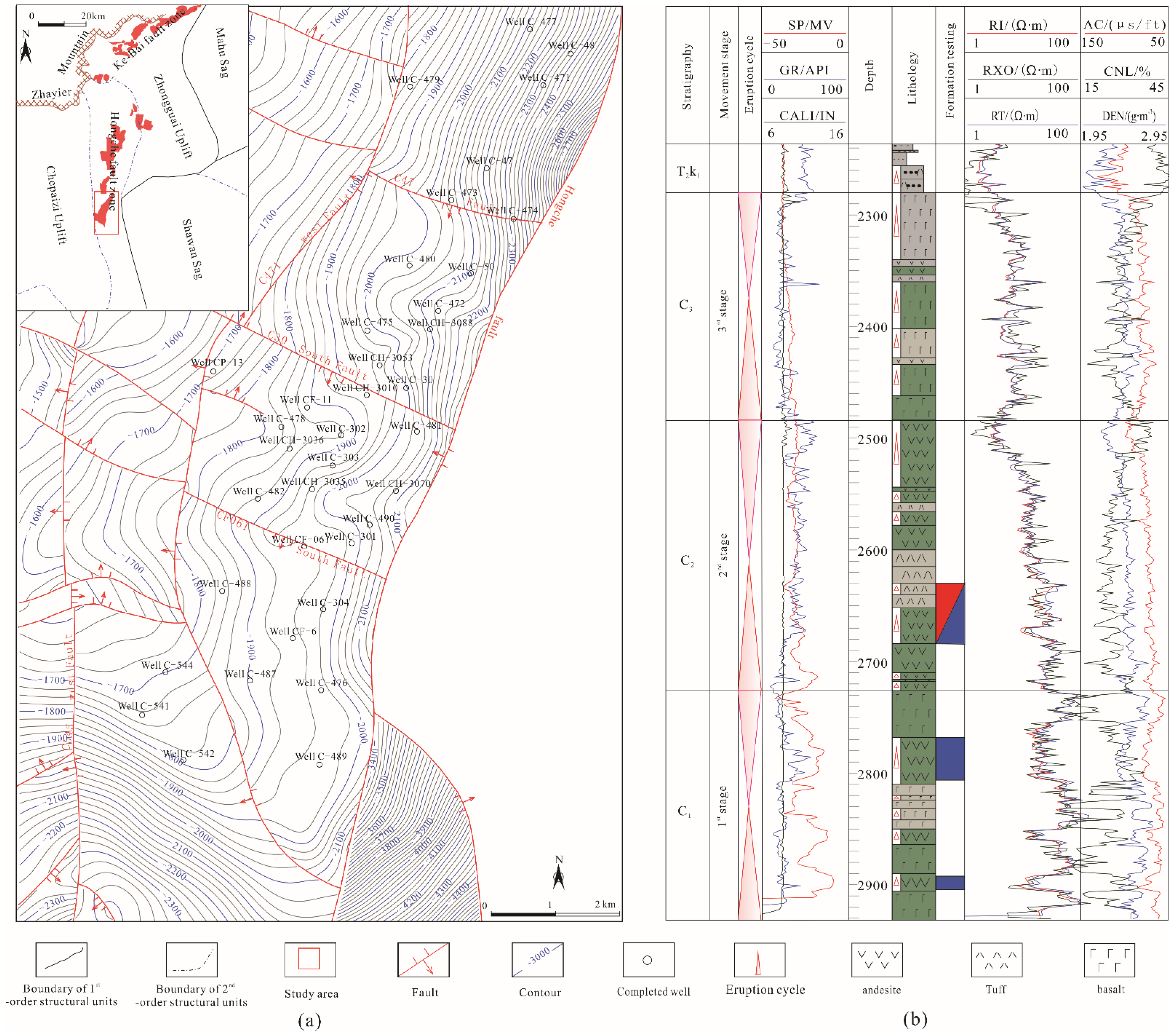
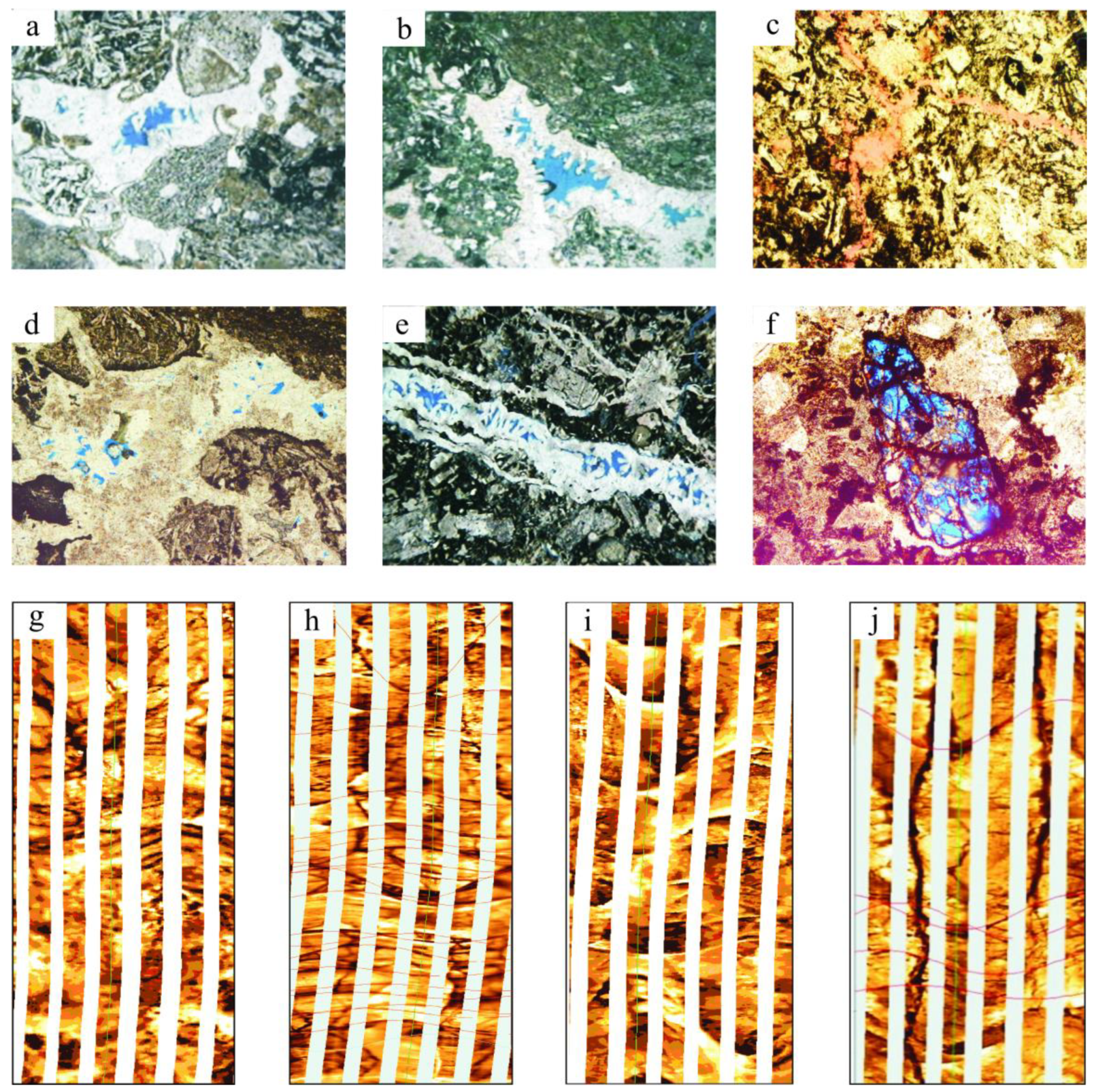
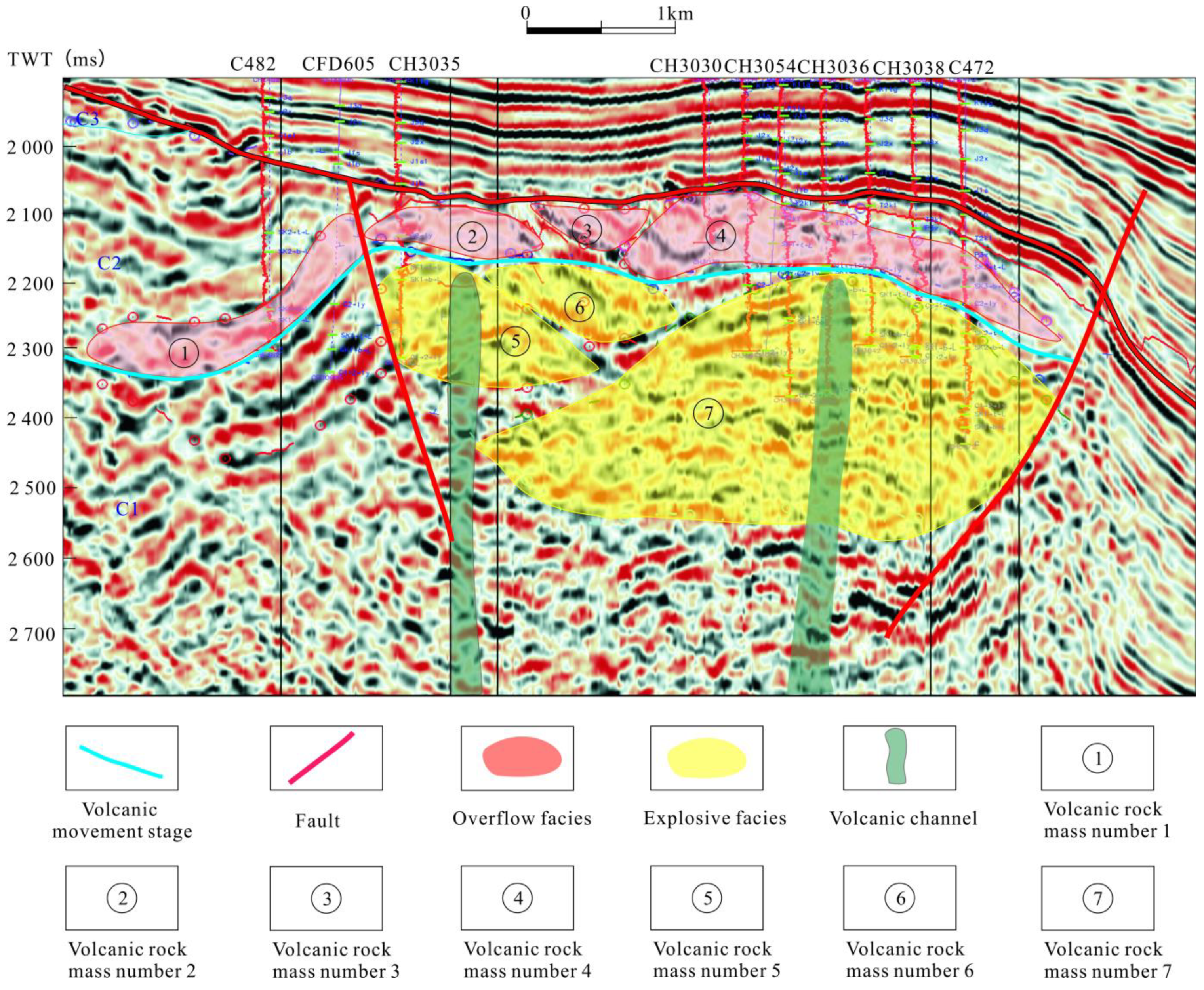
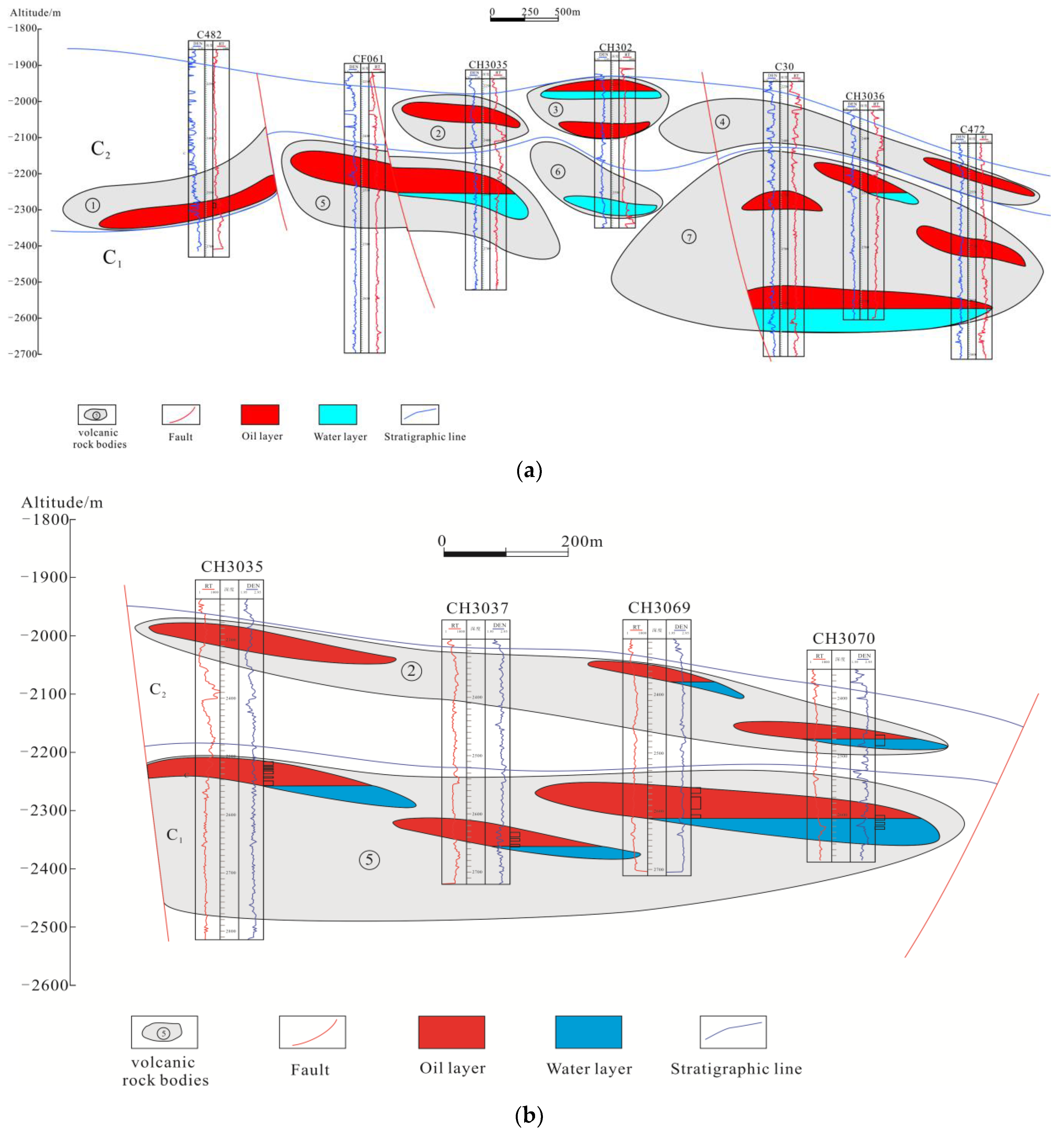

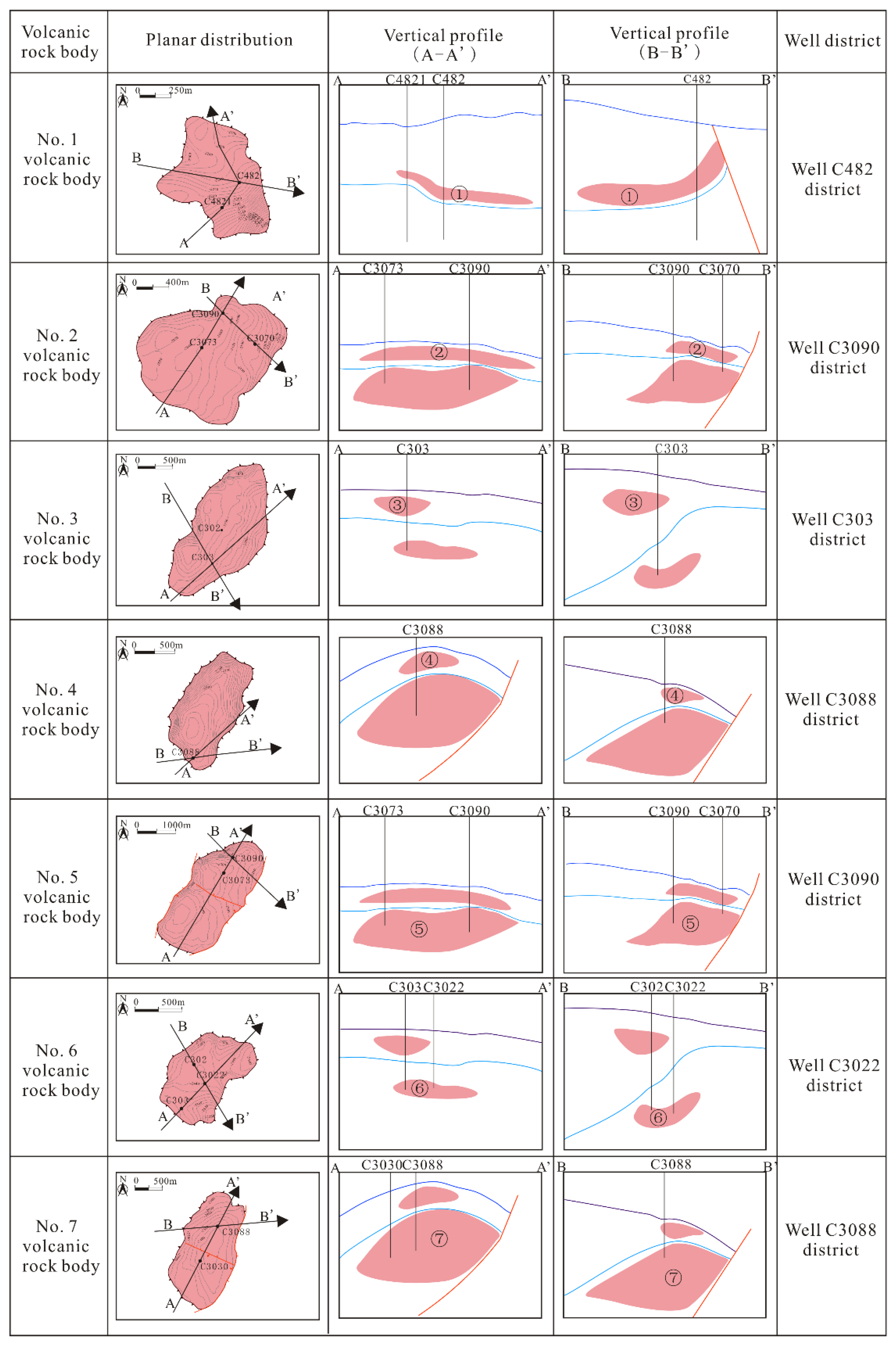
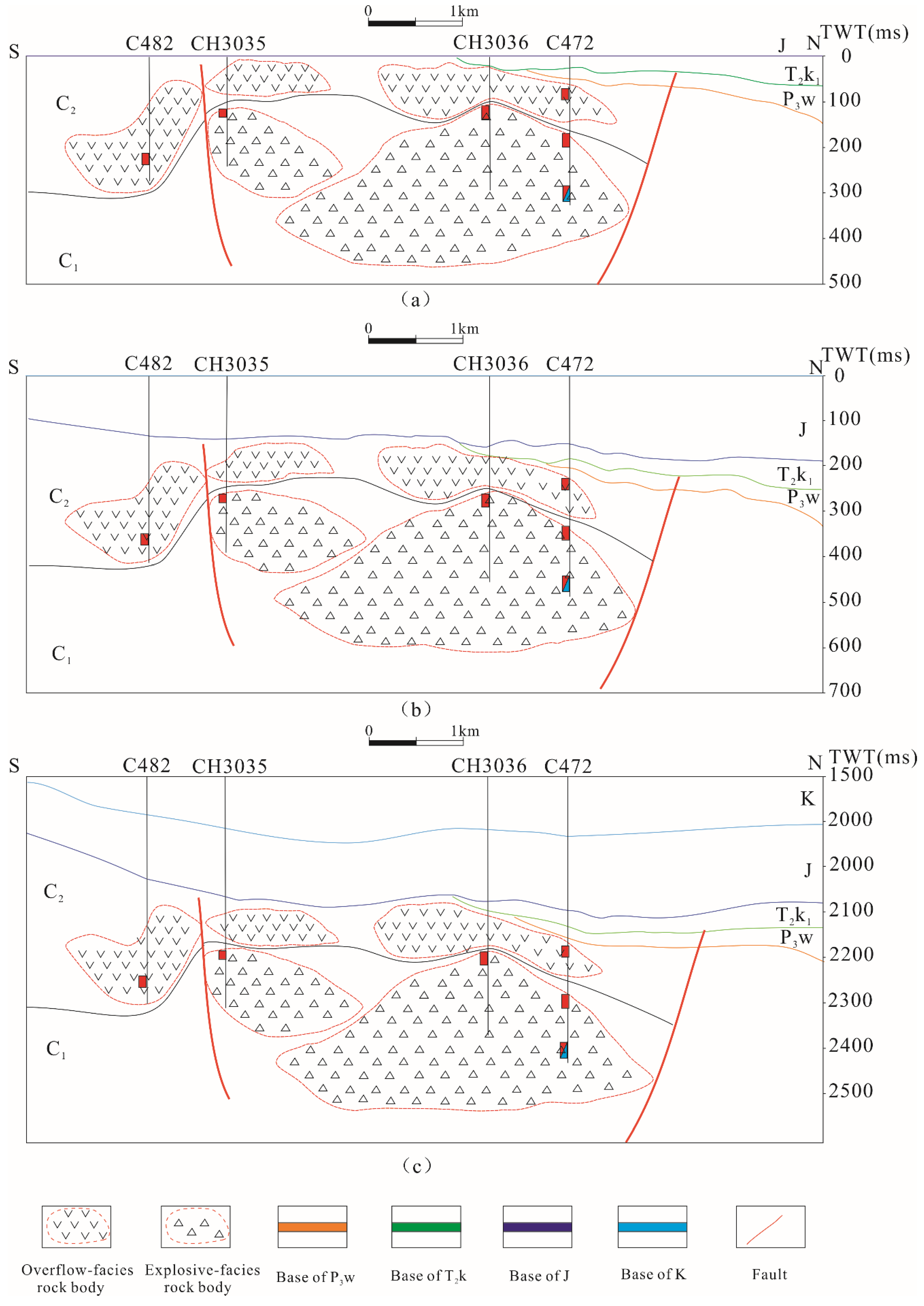

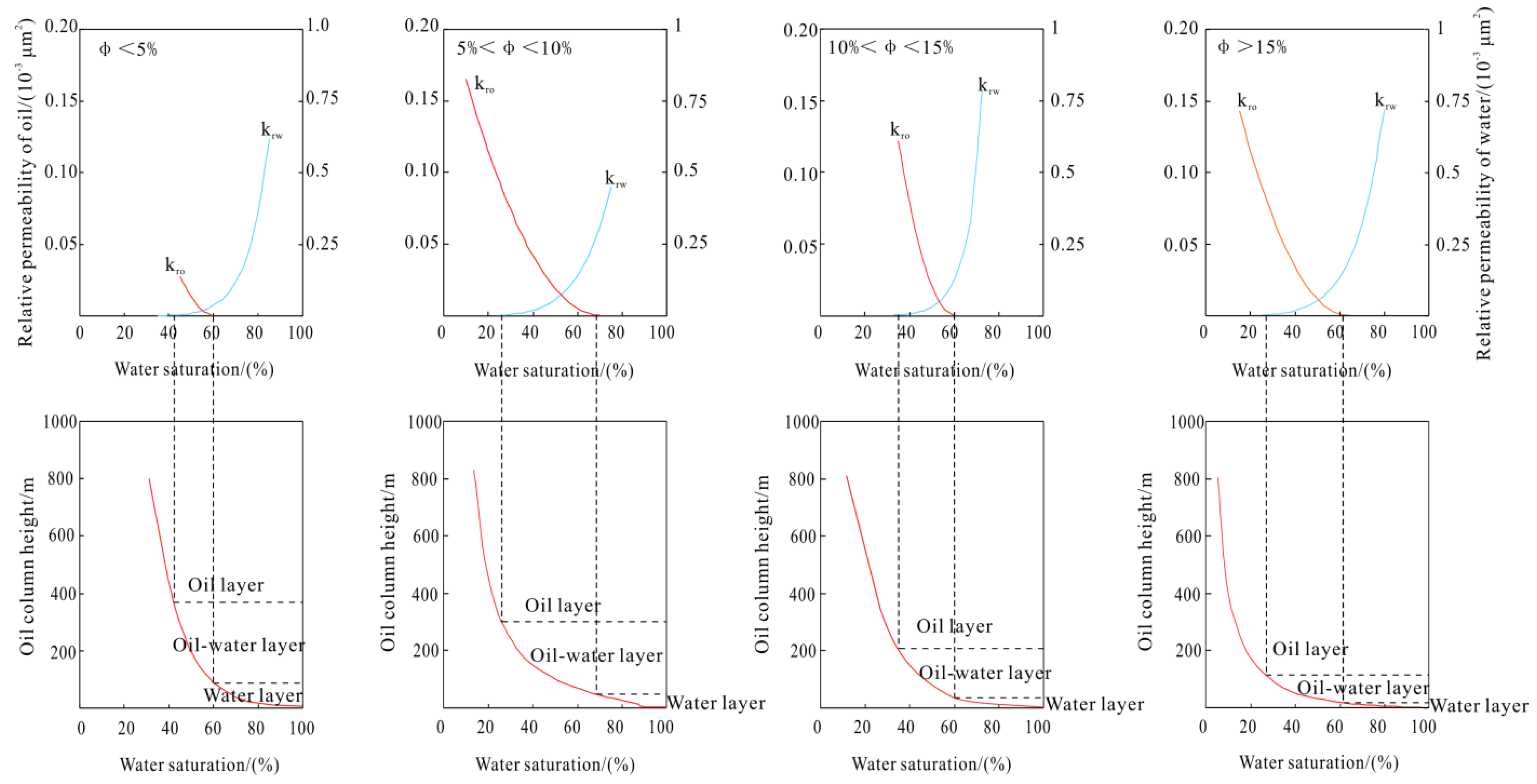
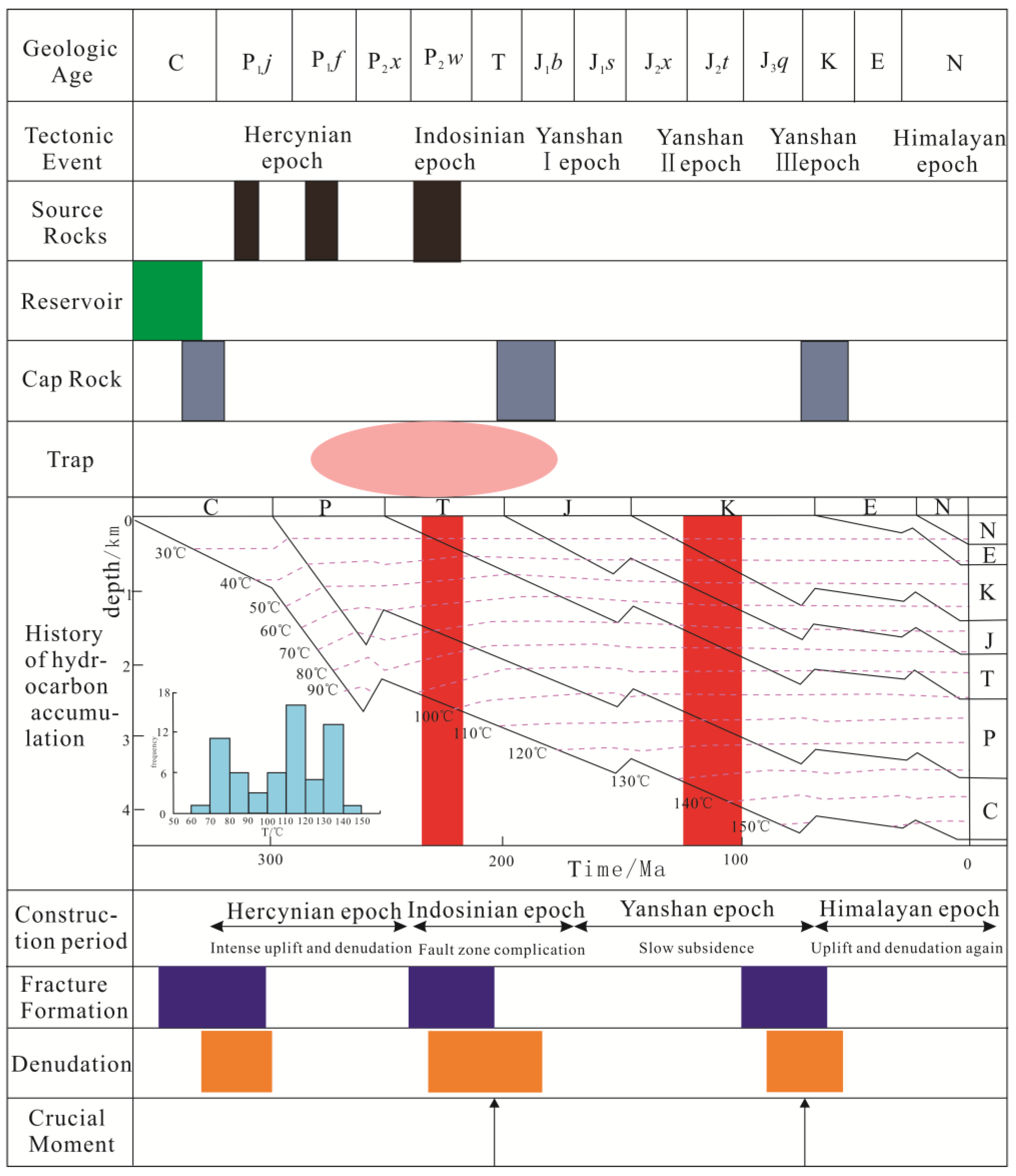
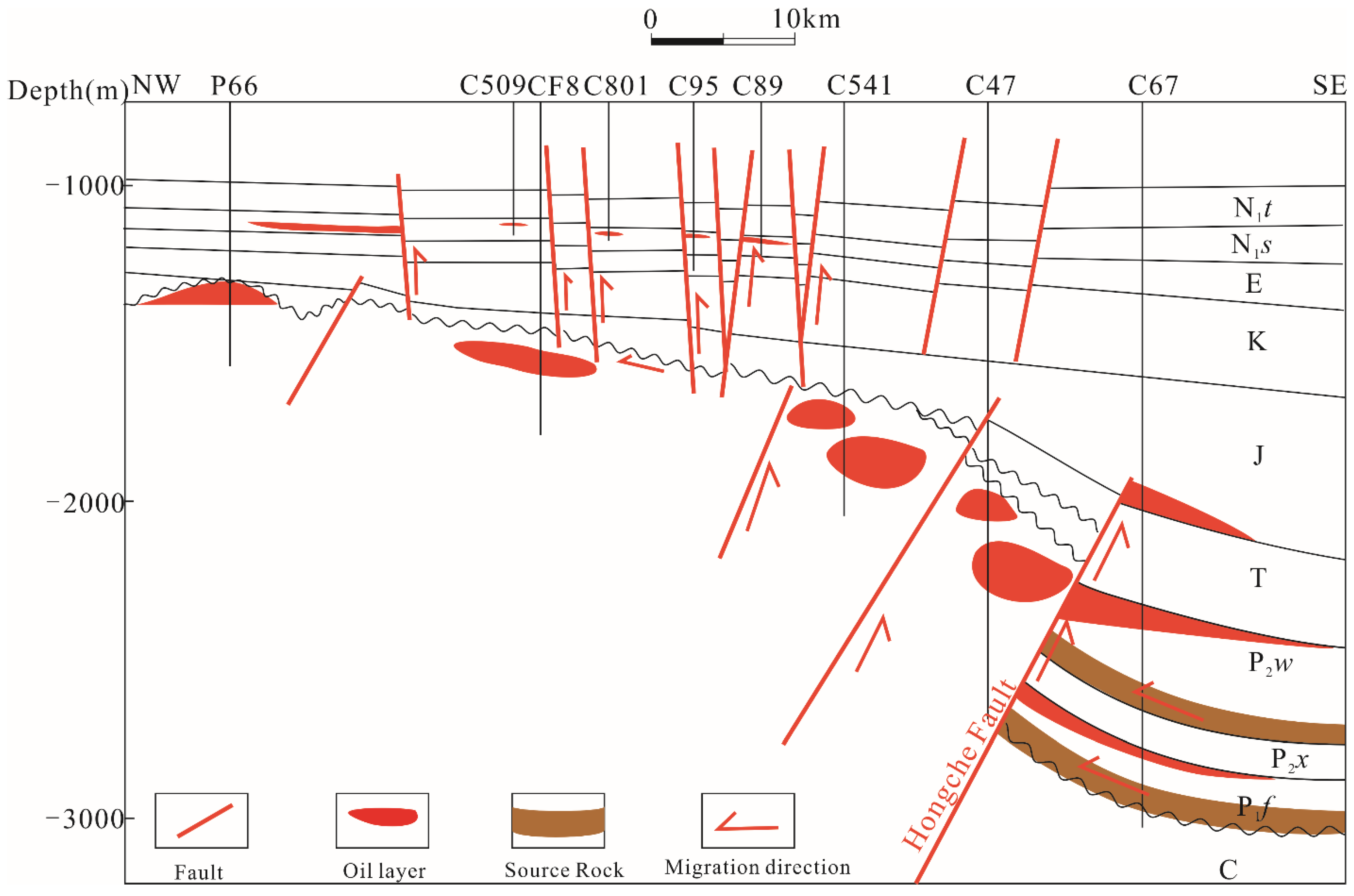
| Formation | TOC /wt% | S1 + S2 /mg·g−1 | Chloroform Bitumen A /% | Carbon Isotope δ13C /‰ | %Ro,ran /% | Kerogen Type |
|---|---|---|---|---|---|---|
| P1f | 1.26 | 0.73 | 0.15 | −28.7~−31.9 | 0.85~1.16 | I–II |
| P2w | 0.7~1.4 | 0.57 | 0.0088 | −25.5~−20.2 | 0.86 | II |
| Fault Name | Fault Nature | Disconnect the Formation | Fault Distance /m | Attitude of Fault | Extension Length /km | |
|---|---|---|---|---|---|---|
| Alignment | Direction | |||||
| Hongche Fault | compressional | J~C | 100~2000 | NW | W | 29.2 |
| C471 West Fault | compressional | J~C | 40~300 | NW | W | 25.1 |
| C545 West Fault | compressional | K~C | 10~20 | NW | W | 28.5 |
| C47 Fault | centripetal | C | 10~80 | EW | S | 14.5 |
| C30 South Fault | centripetal | C | 10~20 | EW | S | 5.98 |
| CF061 South Fault | centripetal | C | 10~20 | EW | S | 5.89 |
Publisher’s Note: MDPI stays neutral with regard to jurisdictional claims in published maps and institutional affiliations. |
© 2022 by the authors. Licensee MDPI, Basel, Switzerland. This article is an open access article distributed under the terms and conditions of the Creative Commons Attribution (CC BY) license (https://creativecommons.org/licenses/by/4.0/).
Share and Cite
Li, X.; Pan, H.; Wu, Y.; Luo, G.; Song, J.; Yang, L.; Gu, K.; Jin, P.; Wang, S.; Li, T.; et al. Main Control Factors and Hydrocarbon Accumulation Model of Volcanic Oil Reservoirs with Complex Oil–Water Relationships: A Case Study of the Carboniferous in the Chepaizi Uplift, the Junggar Basin, China. Minerals 2022, 12, 1357. https://doi.org/10.3390/min12111357
Li X, Pan H, Wu Y, Luo G, Song J, Yang L, Gu K, Jin P, Wang S, Li T, et al. Main Control Factors and Hydrocarbon Accumulation Model of Volcanic Oil Reservoirs with Complex Oil–Water Relationships: A Case Study of the Carboniferous in the Chepaizi Uplift, the Junggar Basin, China. Minerals. 2022; 12(11):1357. https://doi.org/10.3390/min12111357
Chicago/Turabian StyleLi, Xiaoshan, Hong Pan, Yuxiao Wu, Guanxing Luo, Junqiang Song, Liu Yang, Kaifang Gu, Ping Jin, Shuo Wang, Ting Li, and et al. 2022. "Main Control Factors and Hydrocarbon Accumulation Model of Volcanic Oil Reservoirs with Complex Oil–Water Relationships: A Case Study of the Carboniferous in the Chepaizi Uplift, the Junggar Basin, China" Minerals 12, no. 11: 1357. https://doi.org/10.3390/min12111357
APA StyleLi, X., Pan, H., Wu, Y., Luo, G., Song, J., Yang, L., Gu, K., Jin, P., Wang, S., Li, T., & Zhang, L. (2022). Main Control Factors and Hydrocarbon Accumulation Model of Volcanic Oil Reservoirs with Complex Oil–Water Relationships: A Case Study of the Carboniferous in the Chepaizi Uplift, the Junggar Basin, China. Minerals, 12(11), 1357. https://doi.org/10.3390/min12111357







